Assessing Net Environmental and Economic Impacts of Urban Forests: An Online Decision Support Tool
Abstract
1. Introduction
2. Methods: NBenefit$ from Concept to Online Decision Support Tool
2.1. NBenefit$ Design Step
| Early Planning/Design Stages | Intermediate and Advanced Planning/Design Stages | |
|---|---|---|
| Second Level Archetypes *** | First Level Archetypes ** | Disaggregated Archetypes * |
| Mixed urban forest (75% evergreen/25% deciduous) | Evergreen urban forest | Quercus ilex |
| Eucaliptus globulus | ||
| Brachychiton populneum | ||
| Acacia melanoxylon | ||
| Magnolia grandiflora | ||
| Ceratonia siliqua | ||
| Cedrus deodara | ||
| Juniperus virginiana | ||
| Ilex Opaca | ||
| Prunus caroliniana | ||
| Mixed urban forest (50% evergreen/50% deciduous) | Pinus sylvestris | |
| Pinus nigra | ||
| Pinus strobus | ||
| Pinus radiata | ||
| Deciduous urban forest | Platanus acerifolia | |
| Tilia cordata | ||
| Acer palmatum | ||
| Prunus serrulata | ||
| Aesculus hippocastanum | ||
| Mixed urban forest (25% evergreen/75% deciduous) | Quercus palustris | |
| Fraxinus americana | ||
| Celtis occidentalis | ||
| Populus balsamifera subsp. Trichocarpa | ||
| Pyrus calleryana ‘Bradford’ | ||
| Robinia pseudoacacia | ||
| Carpinus betulus ‘fastigiata’ | ||
| Betula pendula | ||
| Liquidambar styraciflua | ||
2.2. NBenefit$ Building Step
2.2.1. Offline Archetype Model and Archetype Database
2.2.2. Calculation Service
2.2.3. Web User Interface
2.3. NBenefit$ Operation Step
2.4. NBenefit$ Outputs
3. Application of NBenefit$ to Evaluate Urban Forests
3.1. Biophysical and Monetary Outputs of NBenefit$ for 48 Urban Forest Archetypes
3.2. Evaluation of Three Hypothetical Alternatives for A Small Urban Forest


4. Discussion and Conclusions
Supplementary Materials
Author Contributions
Funding
Data Availability Statement
Acknowledgments
Conflicts of Interest
References
- Keeler, B.L.; Hamel, P.; McPhearson, T.; Hamann, M.H.; Donahue, M.L.; Meza Prado, K.A.; Arkema, K.K.; Bratman, G.N.; Brauman, K.A.; Finlay, J.C.; et al. Social-Ecological and Technological Factors Moderate the Value of Urban Nature. Nat. Sustain. 2019, 2, 29–38. [Google Scholar] [CrossRef]
- Grace, M.; Balzan, M.; Collier, M.; Geneletti, D.; Tomaskinova, J.; Abela, R.; Borg, D.; Buhagiar, G.; Camilleri, L.; Cardona, M.; et al. Priority Knowledge Needs for Implementing Nature-Based Solutions in the Mediterranean Islands. Environ. Sci. Policy 2021, 116, 56–68. [Google Scholar] [CrossRef]
- Frantzeskaki, N.; Vandergert, P.; Connop, S.; Schipper, K.; Zwierzchowska, I.; Collier, M.; Lodder, M. Examining the Policy Needs for Implementing Nature-Based Solutions in Cities: Findings from City-Wide Transdisciplinary Experiences in Glasgow (UK), Genk (Belgium) and Pozna ń (Poland). Land Use Policy 2020, 96, 104688. [Google Scholar] [CrossRef]
- MEA. Ecosystems and Human Well-Being: General Synthesis; Island Press: Washington, DC, USA, 2005. [Google Scholar]
- European Commission—Directorate-General for Research and Innovation. Evaluating the Impact of Nature-Based Solutions: A Summary for Policy Makers. 2021. Available online: https://data.europa.eu/doi/10.2777/521937 (accessed on 20 November 2021).
- Cohen-Sacham, E.; Walters, G.; Janzen, C.; Maginnis, S. Nature-Based Solutions to Address Global Societal Challenges; IUCN: Gland, Switzerland, 2016. [Google Scholar]
- Babí Almenar, J.; Elliot, T.; Rugani, B.; Philippe, B.; Navarrete, T.; Sonnemann, G.; Geneletti, D. Nexus between Nature-Based Solutions, Ecosystem Services and Urban Challenges. Land Use Policy 2021, 100, 104898. [Google Scholar] [CrossRef]
- FAO. Guidelines on Urban and Peri-Urban Forestry; Salbitano, F., Borelli, S., Conigliaro, M., Chen, Y., Eds.; FAO: Rome, Italy, 2016. [Google Scholar]
- Soto, J.R.; Escobedo, F.J.; Khachatryan, H.; Adams, D.C. Consumer Demand for Urban Forest Ecosystem Services and Disservices: Examining Trade-Offs Using Choice Experiments and Best-Worst Scaling. Ecosyst. Serv. 2018, 29, 31–39. [Google Scholar] [CrossRef]
- Nesshöver, C.; Assmuth, T.; Irvine, K.N.; Rusch, G.M.; Waylen, K.A.; Delbaere, B.; Haase, D.; Jones-Walters, L.; Keune, H.; Kovacs, E.; et al. The Science, Policy and Practice of Nature-Based Solutions: An Interdisciplinary Perspective. Sci. Total Environ. 2017, 579, 1215–1227. [Google Scholar] [CrossRef]
- Artmann, M.; Sartison, K. The Role of Urban Agriculture as a Nature-Based Solution: A Review for Developing a Systemic Assessment Framework. Sustain. 2018, 10, 1937. [Google Scholar] [CrossRef]
- Haase, D.; Larondelle, N.; Andersson, E.; Artmann, M.; Borgström, S.; Breuste, J.; Gomez-Baggethun, E.; Gren, Å.; Hamstead, Z.; Hansen, R.; et al. A Quantitative Review of Urban Ecosystem Service Assessments: Concepts, Models, and Implementation. Ambio 2014, 43, 413–433. [Google Scholar] [CrossRef]
- Cortinovis, C.; Geneletti, D. A Framework to Explore the Effects of Urban Planning Decisions on Regulating Ecosystem Services in Cities. Ecosyst. Serv. 2019, 38, 100946. [Google Scholar] [CrossRef]
- Schaubroeck, T. A Need for Equal Consideration of Ecosystem Disservices and Services When Valuing Nature; Countering Arguments against Disservices. Ecosyst. Serv. 2017, 26, 95–97. [Google Scholar] [CrossRef]
- von Döhren, P.; Haase, D. Ecosystem Disservices Research: A Review of the State of the Art with a Focus on Cities. Ecol. Indic. 2015, 52, 490–497. [Google Scholar] [CrossRef]
- Lyytimäki, J.; Sipilä, M. Hopping on One Leg—The Challenge of Ecosystem Disservices for Urban Green Management. Urban For. Urban Green. 2009, 8, 309–315. [Google Scholar] [CrossRef]
- Perini, K.; Rosasco, P. Cost-Benefit Analysis for Green Façades and Living Wall Systems. Build. Environ. 2013, 70, 110–121. [Google Scholar] [CrossRef]
- Bianchini, F.; Hewage, K. Probabilistic Social Cost-Benefit Analysis for Green Roofs: A Lifecycle Approach. Build. Environ. 2012, 58, 152–162. [Google Scholar] [CrossRef]
- Mcpherson, E.G.; Kendall, A. A Life Cycle Carbon Dioxide Inventory of the Million Trees Los Angeles Program. Int. J. Life Cycle Assess. 2014, 19, 1653–1665. [Google Scholar] [CrossRef]
- Mcpherson, E.G.; Kendall, A.; Albers, S. Life Cycle Assessment of Carbon Dioxide for Different Arboricultural Practices in Los Angeles, CA. Urban For. Urban Green. 2015, 14, 388–397. [Google Scholar] [CrossRef]
- Ingram, D.L.; Fernandez, R.T. Life Cycle Assessment: A Tool for Determining the Environmental Impact of Horticultural Crop Production. Horttechnology 2012, 22, 275–279. [Google Scholar] [CrossRef]
- Ingram, D.L. Life Cycle Assessment to Study the Carbon Footprint of System Components for Colorado Blue Spruce Field Production and Use. J. Am. Soc. Hortic. Sci. 2013, 138, 3–11. [Google Scholar] [CrossRef]
- Petri, A.C.; Koeser, A.K.; Lovell, S.T.; Ingram, D. How Green Are Trees?—Using Life Cycle Assessment Methods to Assess Net Environmental Benefi Ts 1. J. Environ. Hortic. 2016, 34, 101–110. [Google Scholar] [CrossRef]
- Cabral, P.; Feger, C.; Levrel, H.; Chambolle, M.; Basque, D. Assessing the Impact of Land-Cover Changes on Ecosystem Services: A First Step toward Integrative Planning in Bordeaux, France. Ecosyst. Serv. 2016, 22, 318–327. [Google Scholar] [CrossRef]
- Trodahl, M.I.; Jackson, B.M.; Deslippe, J.R.; Metherell, A.K. Investigating Trade-Offs between Water Quality and Agricultural Productivity Using the Land Utilisation and Capability Indicator (LUCI)—A New Zealand Application. Ecosyst. Serv. 2017, 26, 388–399. [Google Scholar] [CrossRef]
- Peh, K.S.H.; Balmford, A.; Bradbury, R.B.; Brown, C.; Butchart, S.H.M.; Hughes, F.M.R.; Stattersfield, A.; Thomas, D.H.L.; Walpole, M.; Bayliss, J.; et al. TESSA: A Toolkit for Rapid Assessment of Ecosystem Services at Sites of Biodiversity Conservation Importance. Ecosyst. Serv. 2013, 5, 51–57. [Google Scholar] [CrossRef]
- Martínez-López, J.; Bagstad, K.J.; Balbi, S.; Magrach, A.; Voigt, B.; Athanasiadis, I.; Pascual, M.; Willcock, S.; Villa, F. Towards Globally Customizable Ecosystem Service Models. Sci. Total Environ. 2019, 650, 2325–2336. [Google Scholar] [CrossRef]
- Coleman, K.; Jenkinson, D.S. RothC—A Model for the Turnover of Carbon in Soil: Model Description and Users Guide (DOS Version; Updated June 2014). In Evaluation of Soil Organic Matter Models; Springer: Berlin/Heidelberg, Germany, 2014; 26p. [Google Scholar] [CrossRef]
- Shekhar, S.; Xiong, H. Soil and Water Assessment Tool “SWAT”. Encycl. GIS 2008, 1068. [Google Scholar] [CrossRef]
- Golinkoff, J. Biome BGC Version 4.2: Theoretical Framework of Biome-BGC. 2010. Available online: http://www.ntsg.umt.edu/models/bgc/ (accessed on 20 November 2021).
- Hirabayashi, S.; Kroll, C.N.; Nowak, D.J. I-Tree Eco Dry Deposition Model Descriptions. Available online: https://www.itreetools.org/documents/60/i-Tree_Eco_Dry_Deposition_Model_Descriptions_V1.5.pdf (accessed on 20 November 2021).
- Zölch, T.; Maderspacher, J.; Wamsler, C.; Pauleit, S. Using Green Infrastructure for Urban Climate-Proofing: An Evaluation of Heat Mitigation Measures at the Micro-Scale. Urban For. Urban Green. 2016, 20, 305–316. [Google Scholar] [CrossRef]
- Burszta-Adamiak, E.; Mrowiec, M. Modelling of Green Roofs’ Hydrologic Performance Using EPA’s SWMM. Water Sci. Technol. 2013, 68, 36–42. [Google Scholar] [CrossRef]
- Bagstad, K.J.; Semmens, D.J.; Waage, S.; Winthrop, R. A Comparative Assessment of Decision-Support Tools for Ecosystem Services Quantification and Valuation. Ecosyst. Serv. 2013, 5, 27–39. [Google Scholar] [CrossRef]
- Grêt-Regamey, A.; Sirén, E.; Brunner, S.H.; Weibel, B. Review of Decision Support Tools to Operationalize the Ecosystem Services Concept. Ecosyst. Serv. 2017, 26, 306–315. [Google Scholar] [CrossRef]
- Naboni, E.; Natanian, J.; Brizzi, G.; Florio, P.; Chokhachian, A.; Galanos, T.; Rastogi, P. A Digital Workflow to Quantify Regenerative Urban Design in the Context of a Changing Climate. Renew. Sustain. Energy Rev. 2019, 113, 109255. [Google Scholar] [CrossRef]
- Oliver, A.; Pearl, D.S. Rethinking Sustainability Frameworks in Neighbourhood Projects: A Process-Based Approach. Build. Res. Inf. 2018, 46, 513–527. [Google Scholar] [CrossRef]
- Badach, J.; Kolasińska, P.; Paciorek, M.; Wojnowski, W.; Dymerski, T.; Gębicki, J.; Dymnicka, M.; Namieśnik, J. A Case Study of Odour Nuisance Evaluation in the Context of Integrated Urban Planning. J. Environ. Manage. 2018, 213, 417–424. [Google Scholar] [CrossRef] [PubMed]
- Hollberg, A.; Tschetwertak, J.; Schneider, S.; Habert, G. Designing Sustainable Technologies, Products and Policies; Springer International Publishing: Cham, Switzerland, 2018; ISBN 9783319669816. [Google Scholar]
- Landscape Institute. BIM for Landscape; Taylor & Francis: Abingdon, UK, 2016; ISBN 9781317634003. [Google Scholar]
- Peluchetti, A.; Elagiry, M.; Perfido, D.; Cortese, M.; Costa, A. Nature4Cities. Tools for Implementation of Nature-Based Solutions in City Context: The Case Study of Milan. In Nature-based Solutions for Sustainable Urban Planning; Springer: Berlin/Heidelberg, Germany, 2022; pp. 147–169. [Google Scholar]
- Voskamp, I.M.; de Luca, C.; Polo-Ballinas, M.B.; Hulsman, H.; Brolsma, R. Nature-Based Solutions Tools for Planning Urban Climate Adaptation: State of the Art. Sustainability 2021, 13, 6381. [Google Scholar] [CrossRef]
- Egusquiza, A.; Arana-Bollar, M.; Sopelana, A.; Babí Almenar, J. Conceptual and Operational Integration of Governance, Financing, and Business Models for Urban Nature-Based Solutions. Sustainability 2021, 13, 11931. [Google Scholar] [CrossRef]
- Davis, D. Modelled on Software Engineering: Flexible Parametric Models in the Practice of Architecture. Ph.D. Thesis, RMIT University, Melbourne, Australia, 2013. [Google Scholar]
- Muetzelfeldt, R.I.; Massheder, J. The Simile Visual Modelling Environment. Eur. J. Agron. 2003, 18. [Google Scholar] [CrossRef]
- Babi Almenar, J. Characterisation, Biophysical Modelling and Monetary Valuation of Urban Nature-Based Solutions as a Support Tool for Urban Planning and Landscape Design. Ph.D. Thesis, University of Bordeaux, Bordeaux, France, University of Trento, Trento, Italy, 2021. [Google Scholar]
- Costanza, R.; de Groot, R.; Sutton, P.; van der Ploeg, S.; Anderson, S.J.; Kubiszewski, I.; Farber, S.; Turner, R.K. Changes in the Global Value of Ecosystem Services. Glob. Environ. Chang. 2014, 26, 152–158. [Google Scholar] [CrossRef]
- de Groot, R.; Brander, L.; van der Ploeg, S.; Costanza, R.; Bernard, F.; Braat, L.; Christie, M.; Crossman, N.; Ghermandi, A.; Hein, L.; et al. Global Estimates of the Value of Ecosystems and Their Services in Monetary Units. Ecosyst. Serv. 2012, 1, 50–61. [Google Scholar] [CrossRef]
- Troy, A.; Wilson, M.A. Mapping Ecosystem Services: Practical Challenges and Opportunities in Linking GIS and Value Transfer. Ecol. Econ. 2006, 60, 435–449. [Google Scholar] [CrossRef]
- De Bruyn, S.; Ahdour, S.; Bijleveld, M.; De Graaff, L.; Schep, E.; Schroten, A.; Vergeer, R. Environmental Prices Handbook 2017-Methods and Numbers for Valuation of Environmental Impacts. Delft CE Delft 2018, 5–2018. [Google Scholar]
- ESValues. ESValues Platform: Collaborative Platform on Economic Data from Ecosystem Services Studies. Available online: http://www.esvalues.org/ (accessed on 20 October 2021).
- EVRI. The Environmental Valuation Reference Inventory. Available online: https://www.evri.ca/ (accessed on 20 October 2021).
- Petucco, C.; Babí Almenar, J.; Rugani, B.; Maider, A.; Usobiaga, E.; Sopelana, A.; Hernando, S.; Egusquiza, A.; Yilmaz, O.; Naneci, S.; et al. Development of a Monetary Value Scale in MIMES: Deliverable 4.2 of Nature Based Solutions for Re-Naturing Cities: Knowledge Diffusion and Decision Support Platform through New Collaborative Models. 2018. Available online: https://www.list.lu/fileadmin/files/projects/Deliverable_4.2_-_Extract___Released_on_15.12.18.pdf (accessed on 10 November 2022).
- Plummer, M.L. Assessing Benefit Transfer for the Valuation of Ecosystem Services. Front. Ecol. Environ. 2009, 7, 38–45. [Google Scholar] [CrossRef]
- Brouwer, R.; Navrud, S. The Use and Development of Benefit Transfer in Europe. In Benefit Transfer of Environmental and Resource Values: A Guide for Researchers and Practitioners; Johnston, R.J., Rolfe, J., Rosenberger, R.S., Brouwer, R., Eds.; Springer: Dordrecht, The Netherlands, 2015; pp. 71–83. ISBN 978-94-017-9930-0. [Google Scholar]
- RIBA. RIBA Plan of Work. 2013. Available online: https://www.architecture.com/knowledge-and-resources/resources-landing-page/riba-plan-of-work (accessed on 20 October 2020).
- Gutleben, C.; Goumot, P. Recensement Du Patrimoine Arboré Des Alignements Urbains et de La Répartition Des Essences; Plante & Cité: Angers, France, 2015. [Google Scholar]
- R Core Team. R: A Language and Environment for Statistical Computing; R Core Team: Vienna, Austria, 2020. [Google Scholar]
- Almeida, A.C.; Sands, P.J. Improving the Ability of 3-PG to Model the Water Balance of Forest Plantations in Contrasting Environments. Ecohydrology 2016, 9, 610–630. [Google Scholar] [CrossRef]
- Grandison, A. Determining Confidence Intervals, and Convergence, for Parameters in Stochastic Evacuation Models. Fire Technol. 2020, 56, 2137–2177. [Google Scholar] [CrossRef]
- Hauschild, M.Z.; Rosenbaum, R.K.; Olsen, S.I. Life Cycle Assessment, 1st ed.; Hauschild, M.Z., Rosenbaum, R.K., Olsen, S.I., Eds.; Springer International Publishing: Cham, Switzerland, 2018; ISBN 978-3-319-56474-6. [Google Scholar]
- Huijbregts, M.A.J.; Steinmann, Z.J.N.; Elshout, P.M.F.; Stam, G.; Verones, F.; Vieira, M.; Zijp, M.; Hollander, A.; van Zelm, R. ReCiPe2016: A Harmonised Life Cycle Impact Assessment Method at Midpoint and Endpoint Level. Int. J. Life Cycle Assess. 2017, 22, 138–147. [Google Scholar] [CrossRef]
- Montague, T.; Kjelgren, R.; Allen, R.; Wester, D. Water Loss Estimates for Five Recently Transplanted Landscape Tree Species in a Semi-Arid Climate. J. Environ. Hortic. 2004, 22, 189–196. [Google Scholar] [CrossRef]
- Huttner, S.; Bruse, M. Numerical Modeling of the Urban Climate—A Preview on ENVI-Met 4.0. In Proceedings of the 7th international conference on urban climate ICUC-7, Yokohama, Japan, 29 June–3 July 2009; Volume 29. [Google Scholar]
- Armstrong, K. Emerging Industrial Applications. In Carbon Dioxide Utilisation; Elsevier: Amsterdam, The Netherlands, 2015; pp. 237–251. [Google Scholar]
- Altunok, T.; Cakmak, T. A Technology Readiness Levels (TRLs) Calculator Software for Systems Engineering and Technology Management Tool. Adv. Eng. Softw. 2010, 41, 769–778. [Google Scholar] [CrossRef]
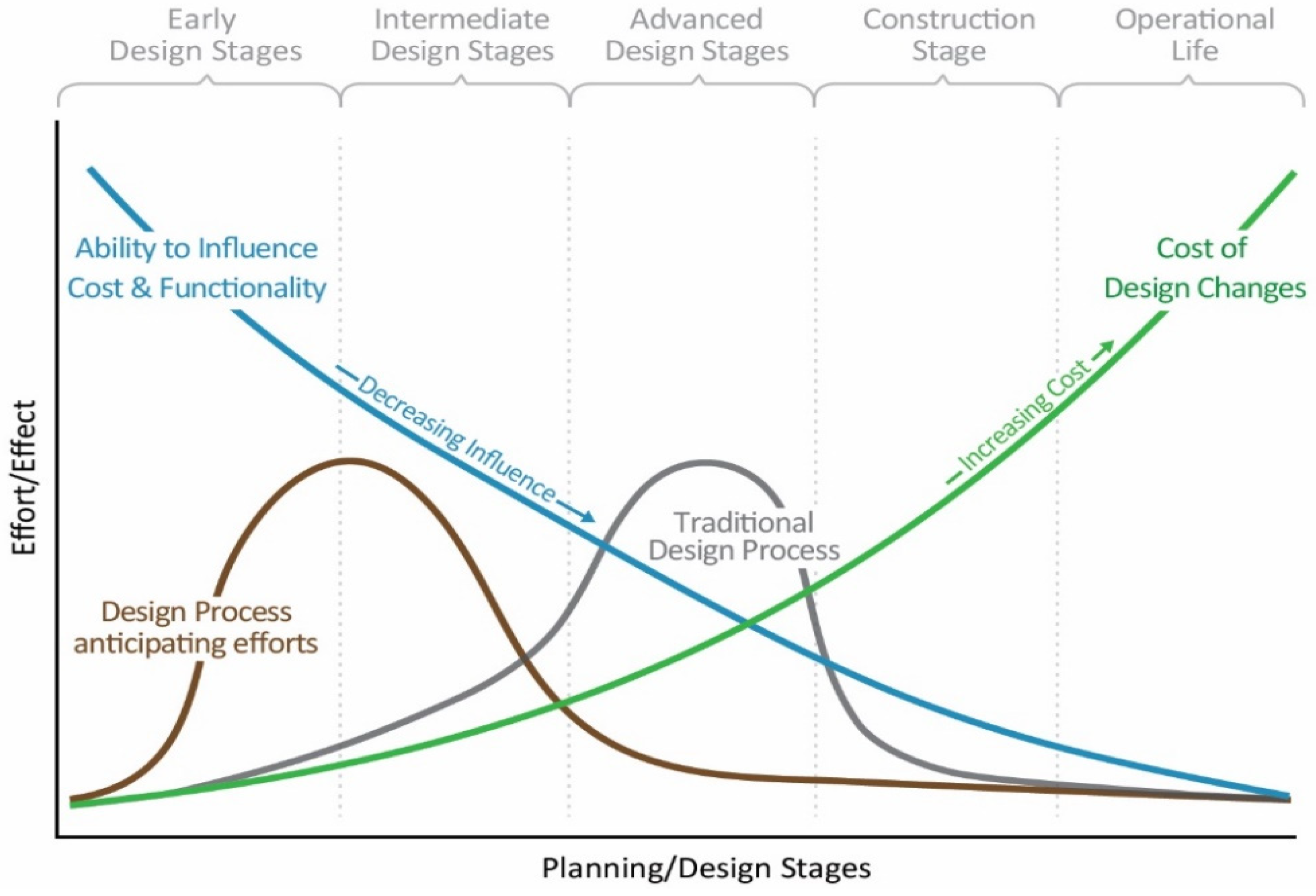
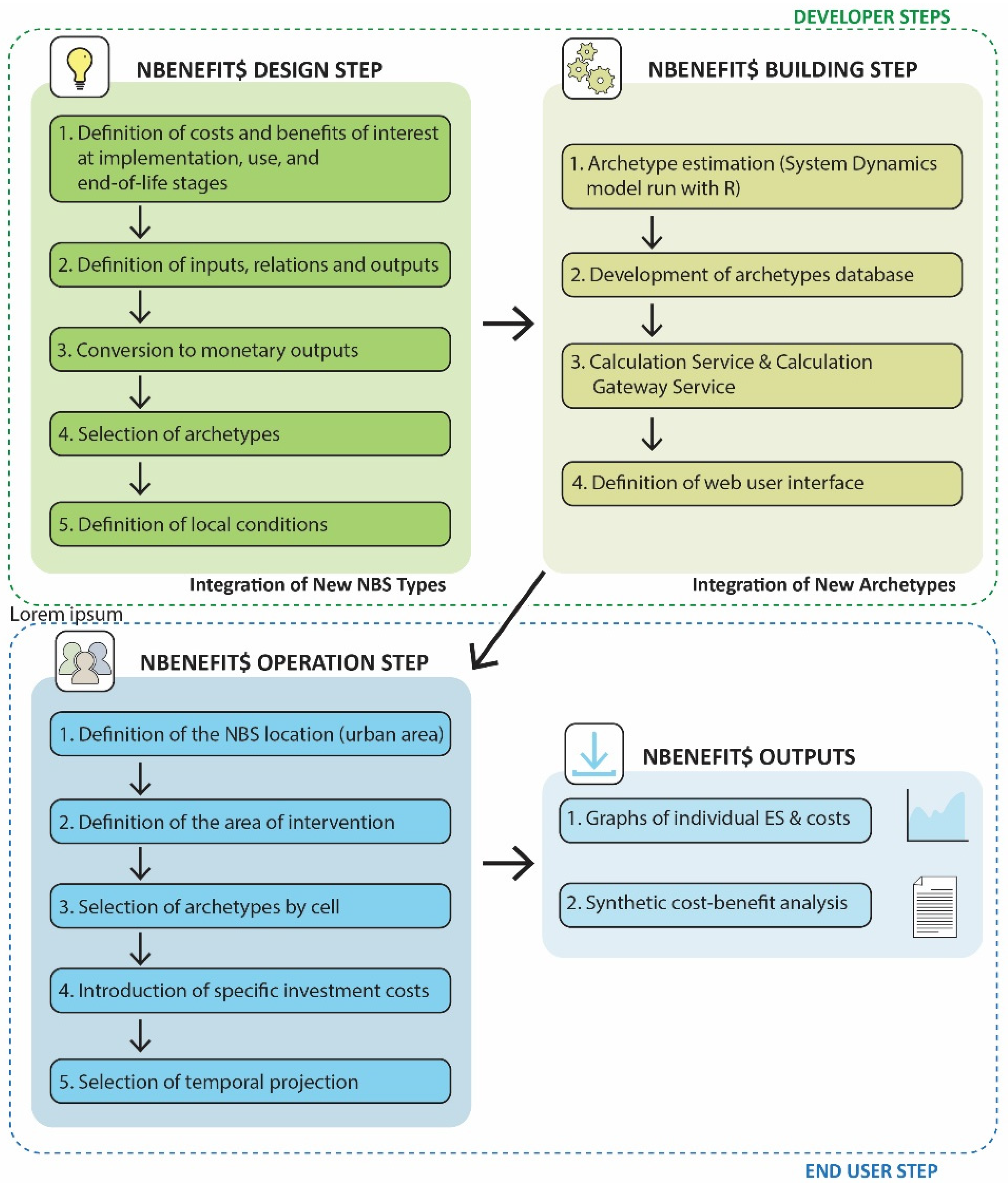
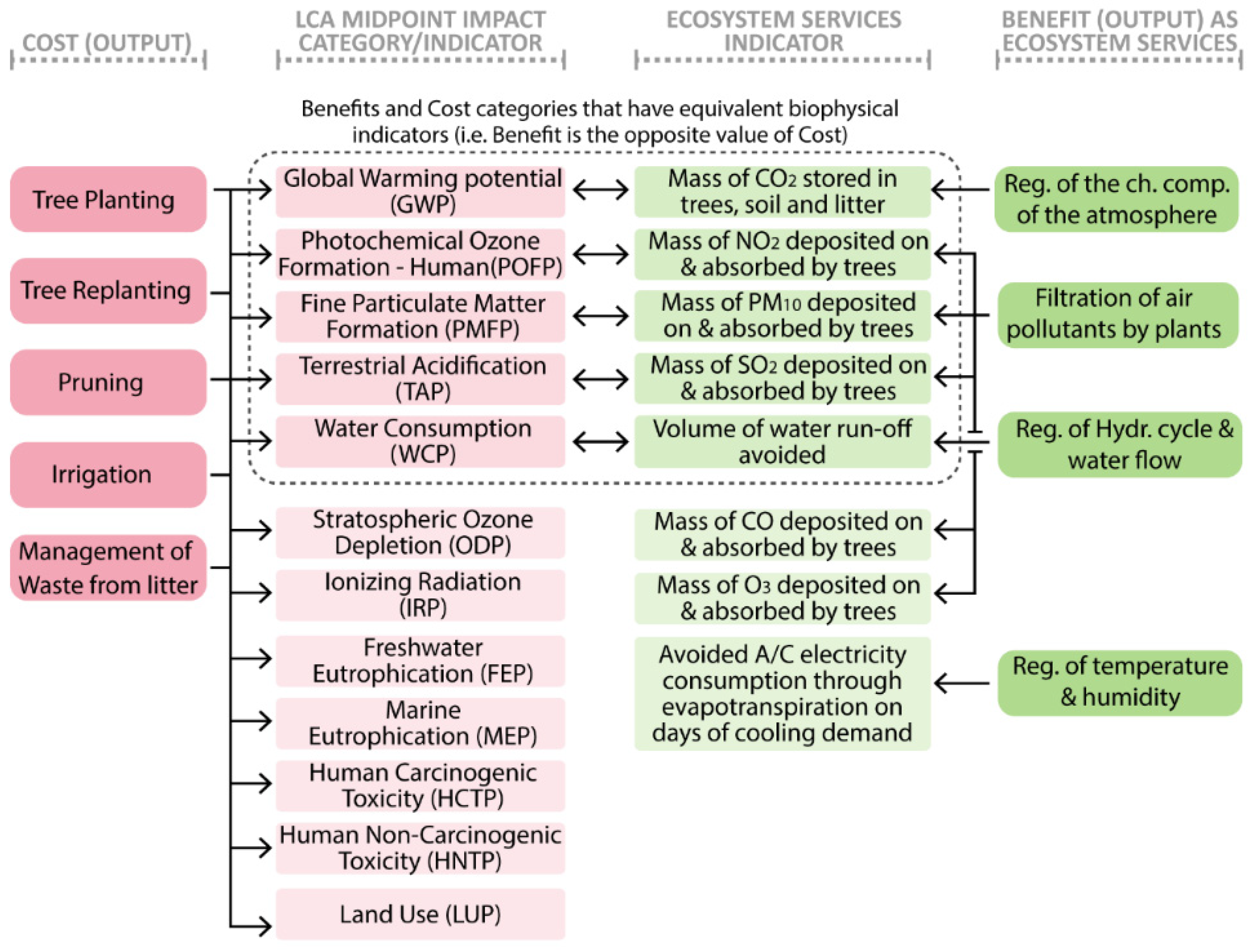
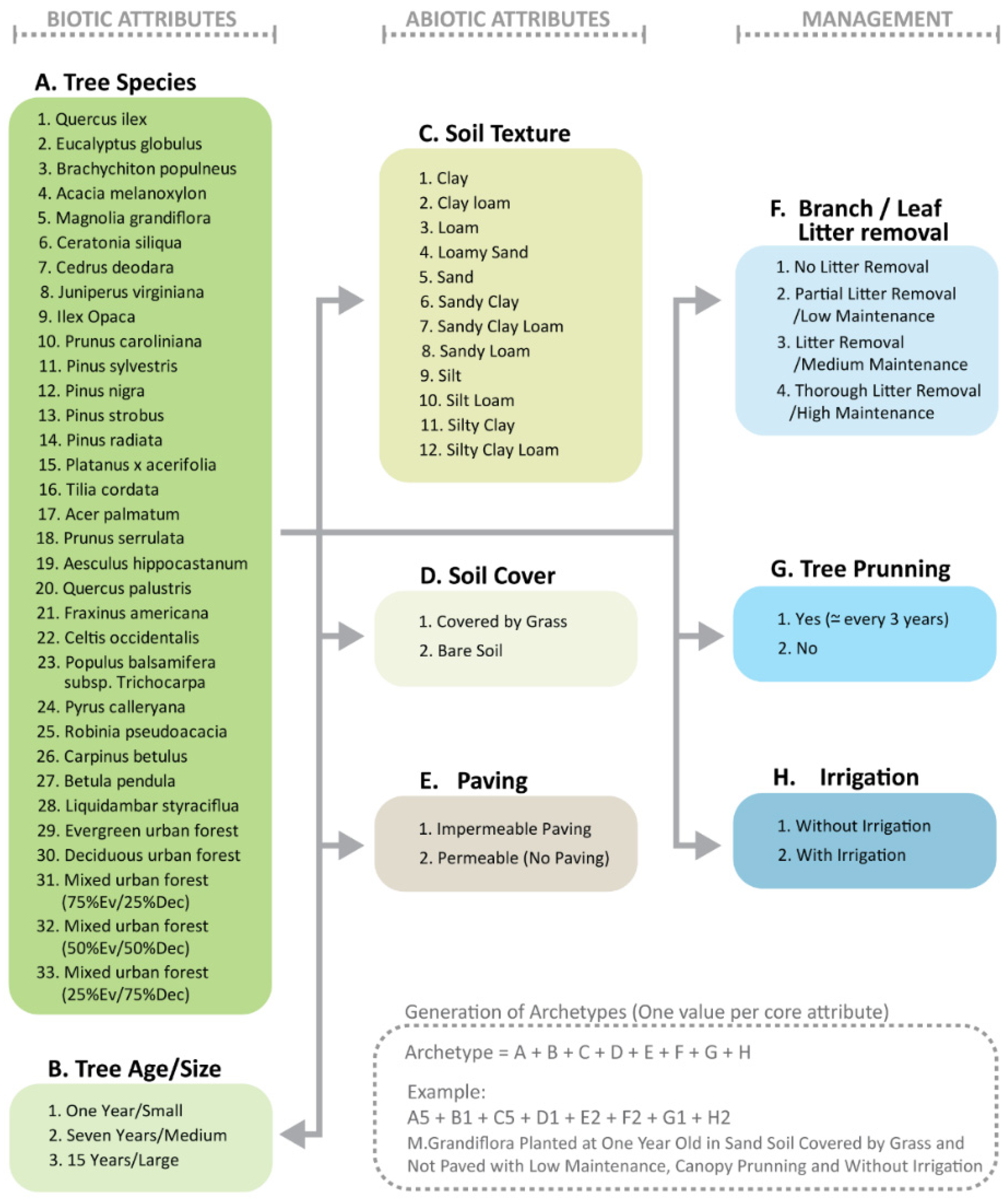
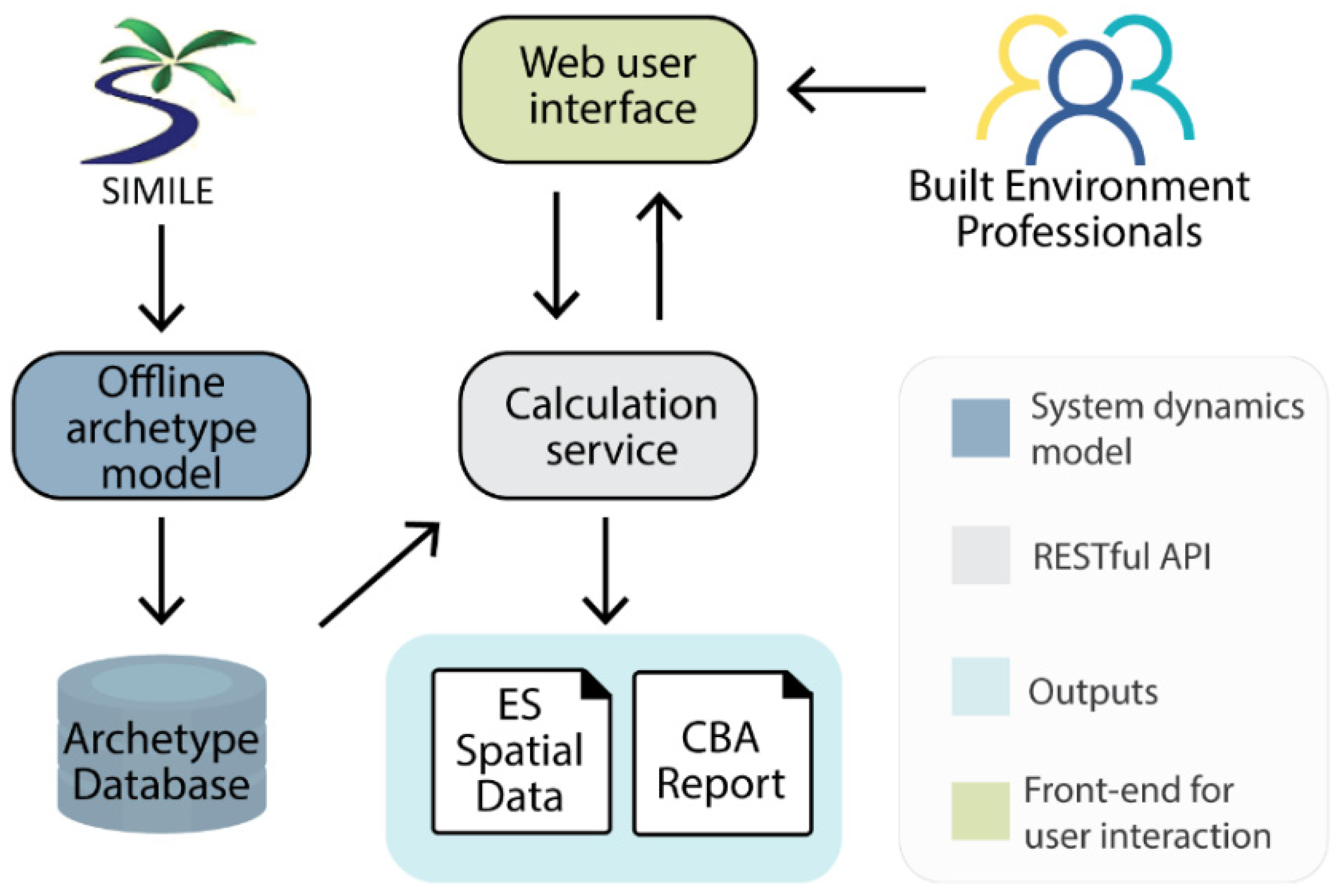
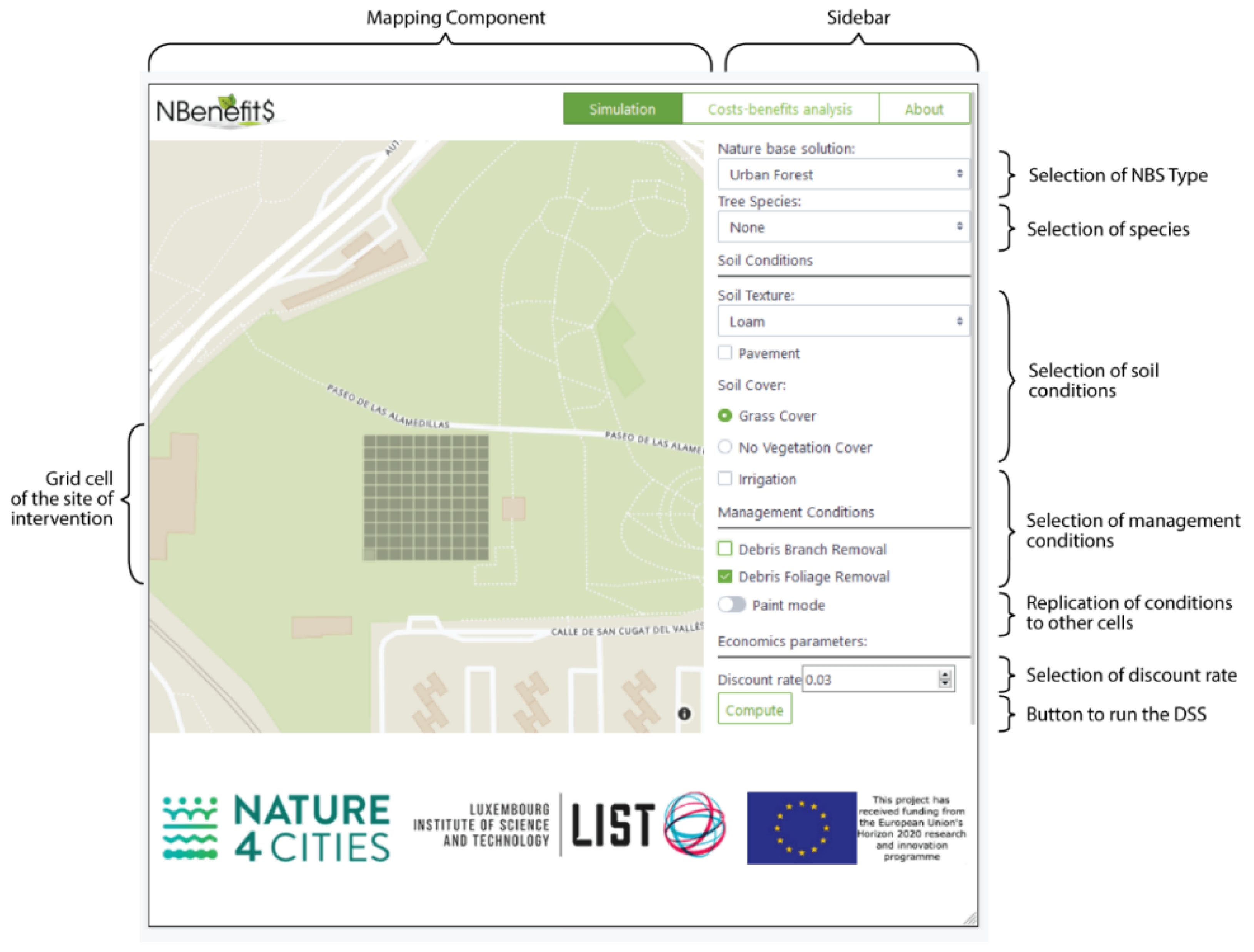

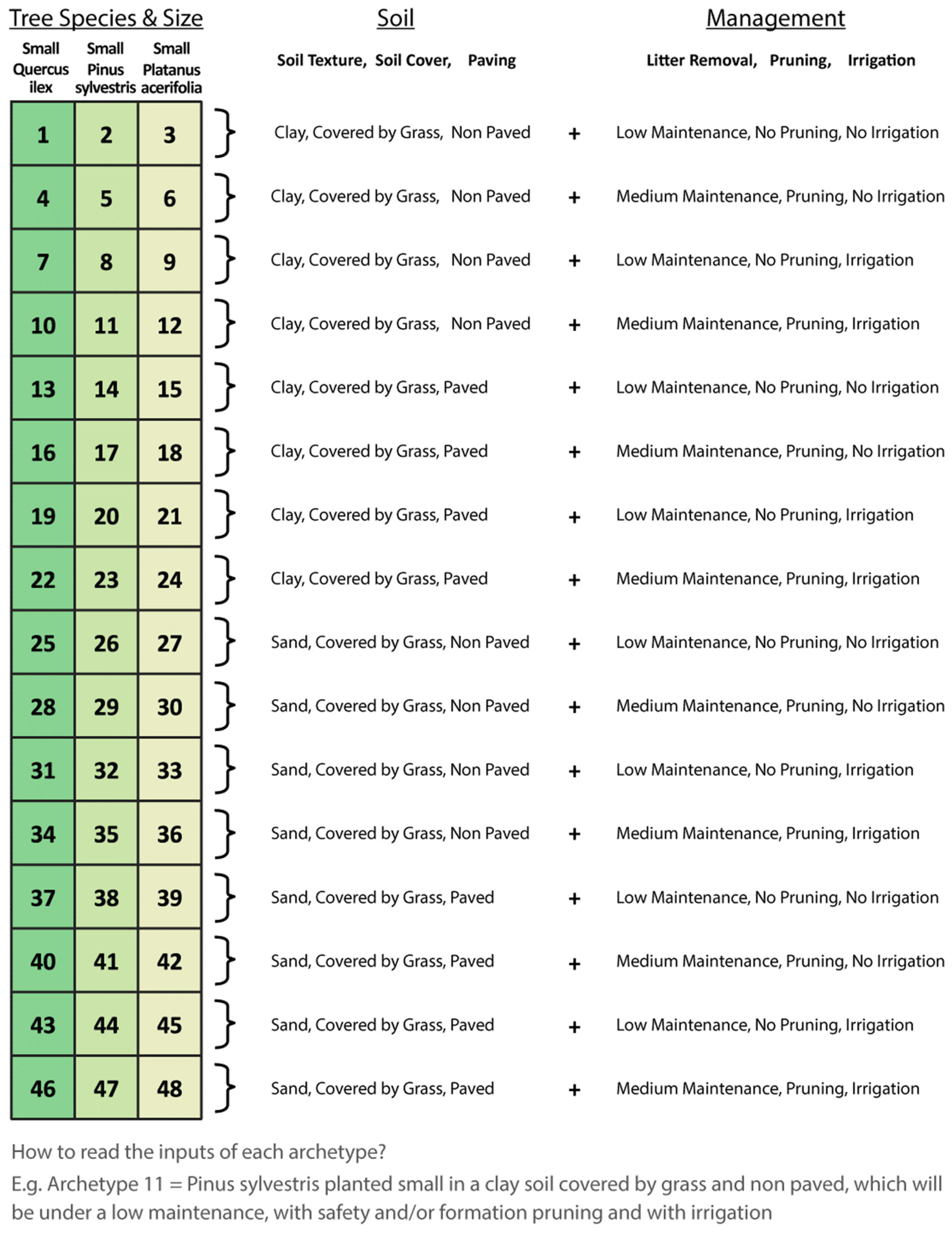

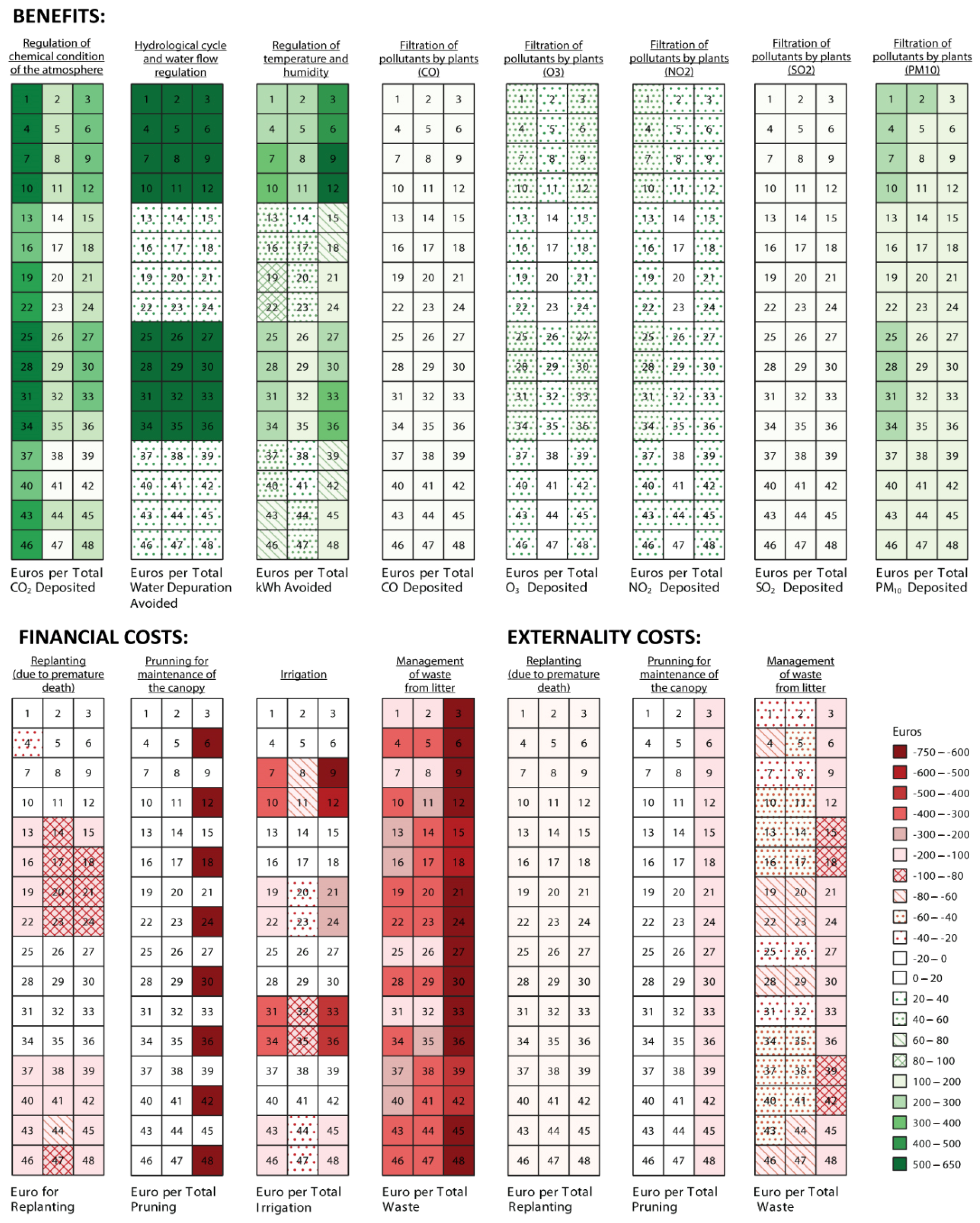
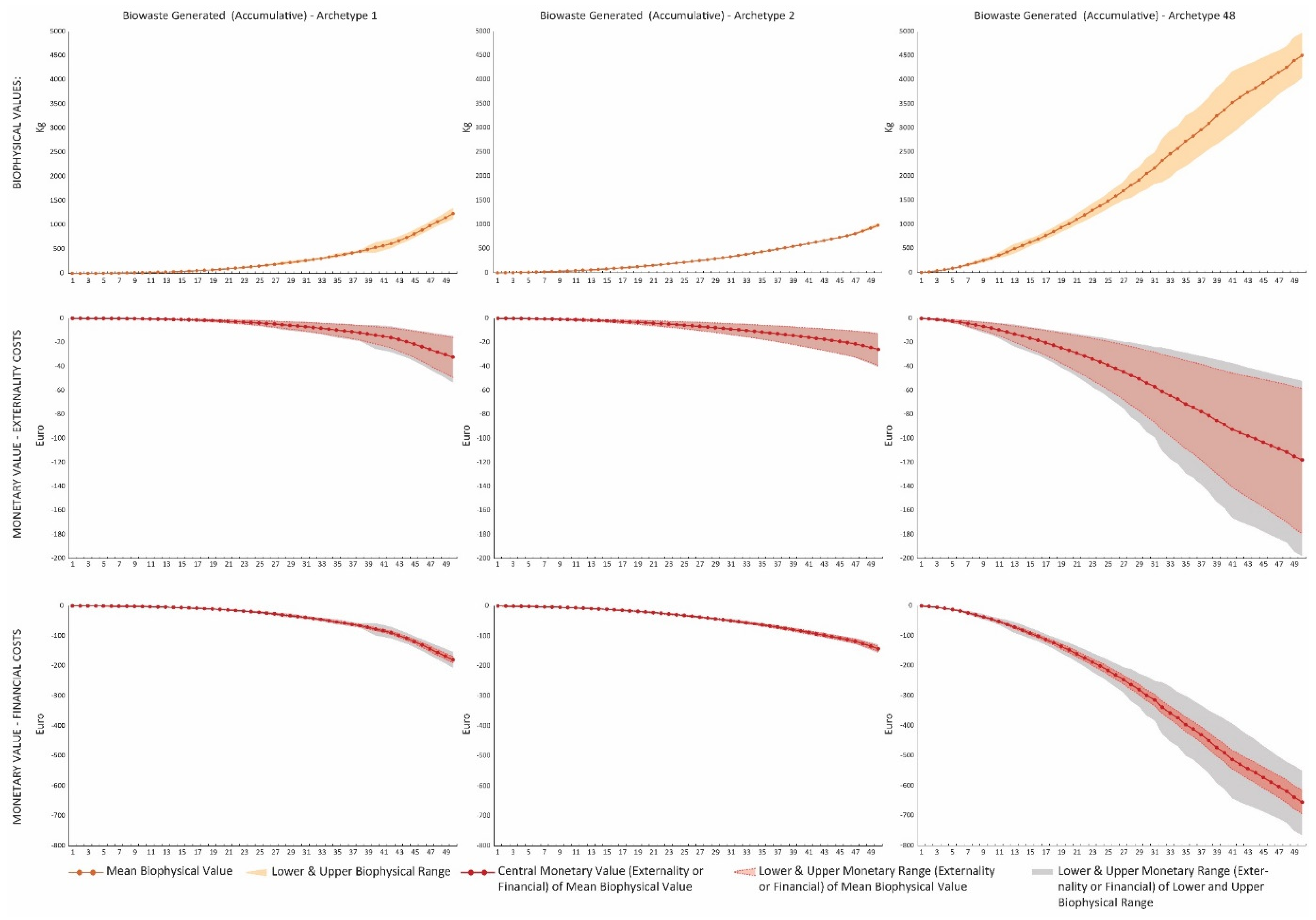
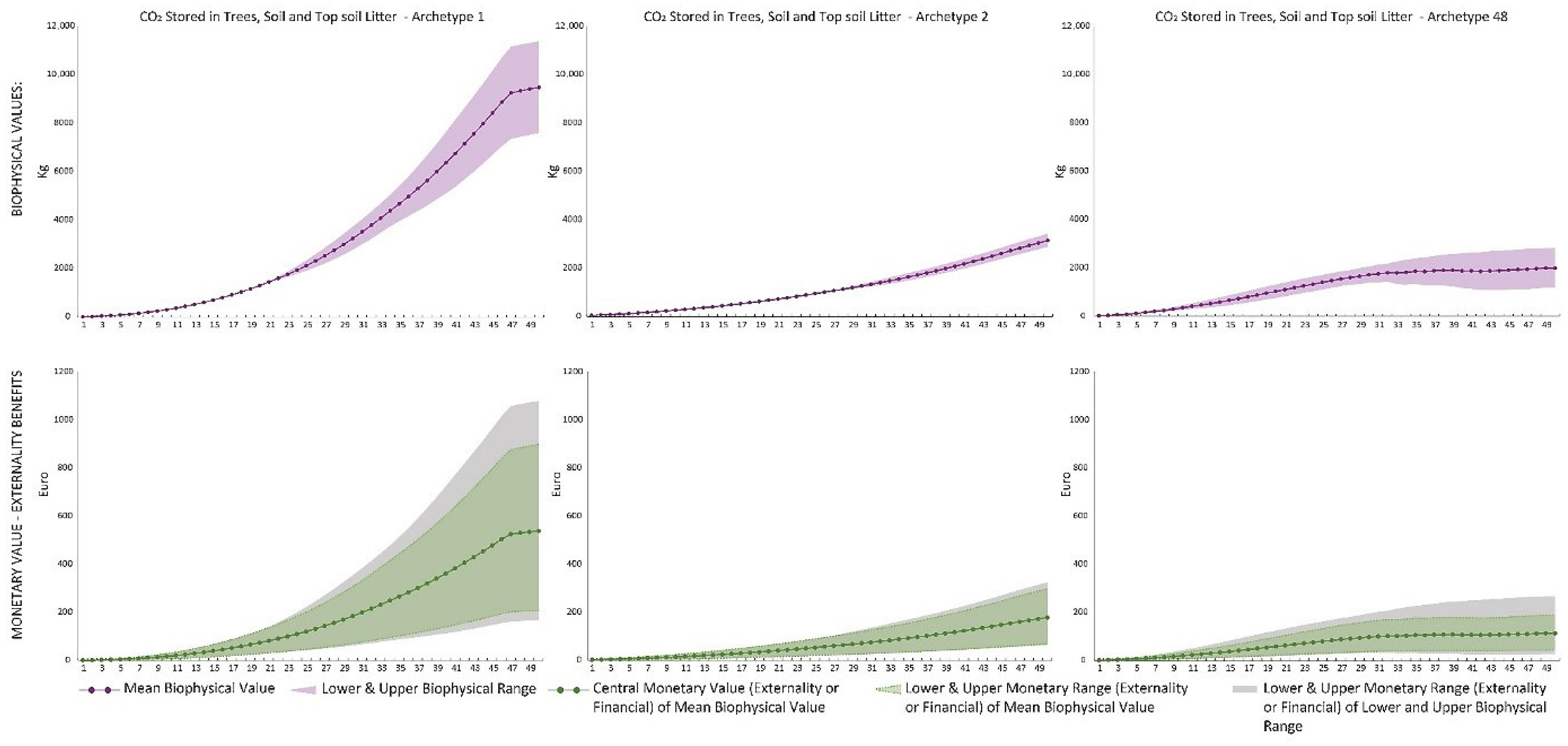
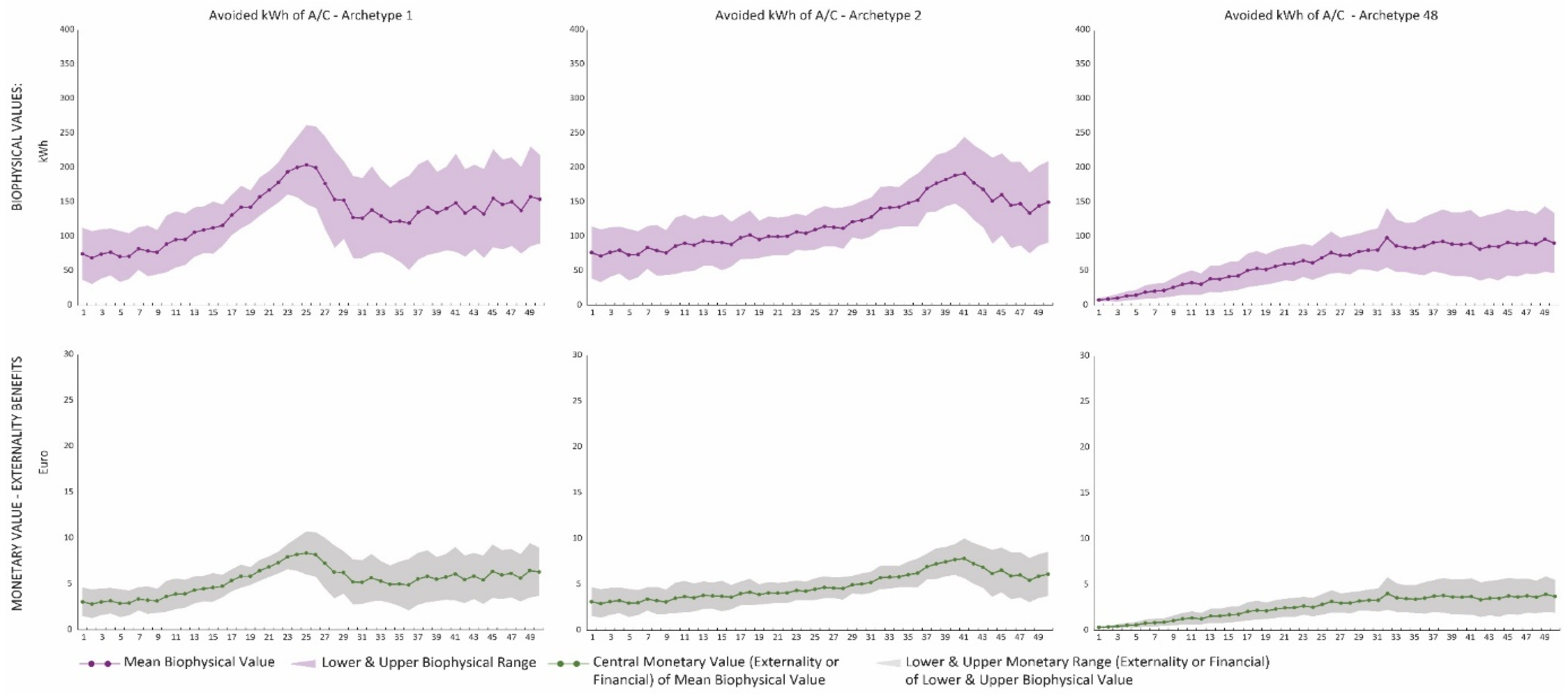

| Costs and Benefits | Life Cycle Phase | Main Processes | Main Biotic, Abiotic, and Management Attributes | |
|---|---|---|---|---|
| Management Actions (COSTS) | Tree planting * | Implementation | Tree management in nurseries, transport to site, planting | Species, initial tree size/age at planting, average transport distance, planting techniques and machinery |
| Amount of tree replanting ** (due to premature death) | Operational | Plants morbidity and plant mortality | Species, initial tree size, stress factors (paving, drought, waterlogging), mortality statistics *** | |
| Pruning | Operational | Vegetation growth (branches) | Species, initial tree size, percent of branch to be pruned, pruning techniques and machinery | |
| Irrigation | Operational | Storage of available soil water, soil evaporation, vegetation transpiration, infiltration, percolation | Soil texture, initial available soil water | |
| Management of waste from litter and dead wood | End-of-life | Leaf, branch decay, and plant mortality | Species, initial tree size, mortality records, branch and leaf decay rate, plant management | |
| Ecosystem Services (BENEFITS) | Regulation of the chemical composition of the atmosphere | Operational | Vegetation growth, drought and waterlogging, death | Species, initial tree size, growth rate, decay rate, soil texture, threshold to stress factors |
| Regulation of temperature and humidity | Operational | Free evaporation during rainy days, soil evaporation, vegetation transpiration | Species, initial tree size, growth rate, ratio tree size to leaf area, daily precipitation, daily temperature, dormant periods (deciduous trees), soil texture, available soil water | |
| Hydrological cycle and water flow regulation | Operational | Vegetation interception, infiltration, percolation, soil evaporation, vegetation transpiration | Species, initial tree size, growth rate, ratio tree size to leaf area, daily precipitation, daily temperature, dormant periods (deciduous trees), soil texture, available soil water | |
| Filtration of pollutants by plants | Operational | Dry deposition, vegetation transpiration | Species, initial tree size, tree height, growth rate, ratio tree size to leaf area, precipitation, temperature, air pollutant levels (CO, NO2, SO2, O3, PM10), wind, solar radiation |
Disclaimer/Publisher’s Note: The statements, opinions and data contained in all publications are solely those of the individual author(s) and contributor(s) and not of MDPI and/or the editor(s). MDPI and/or the editor(s) disclaim responsibility for any injury to people or property resulting from any ideas, methods, instructions or products referred to in the content. |
© 2022 by the authors. Licensee MDPI, Basel, Switzerland. This article is an open access article distributed under the terms and conditions of the Creative Commons Attribution (CC BY) license (https://creativecommons.org/licenses/by/4.0/).
Share and Cite
Babí Almenar, J.; Petucco, C.; Navarrete Gutiérrez, T.; Chion, L.; Rugani, B. Assessing Net Environmental and Economic Impacts of Urban Forests: An Online Decision Support Tool. Land 2023, 12, 70. https://doi.org/10.3390/land12010070
Babí Almenar J, Petucco C, Navarrete Gutiérrez T, Chion L, Rugani B. Assessing Net Environmental and Economic Impacts of Urban Forests: An Online Decision Support Tool. Land. 2023; 12(1):70. https://doi.org/10.3390/land12010070
Chicago/Turabian StyleBabí Almenar, Javier, Claudio Petucco, Tomás Navarrete Gutiérrez, Laurent Chion, and Benedetto Rugani. 2023. "Assessing Net Environmental and Economic Impacts of Urban Forests: An Online Decision Support Tool" Land 12, no. 1: 70. https://doi.org/10.3390/land12010070
APA StyleBabí Almenar, J., Petucco, C., Navarrete Gutiérrez, T., Chion, L., & Rugani, B. (2023). Assessing Net Environmental and Economic Impacts of Urban Forests: An Online Decision Support Tool. Land, 12(1), 70. https://doi.org/10.3390/land12010070






